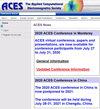Crank-Nicolson时间积分在具有非均匀网格和子网格的FDTD方法中的可证明的稳定局部应用
IF 0.6
4区 计算机科学
Q4 ENGINEERING, ELECTRICAL & ELECTRONIC
Applied Computational Electromagnetics Society Journal
Pub Date : 2018-03-01
DOI:10.23919/ROPACES.2018.8364206
引用次数: 1
摘要
这一贡献消除了对有限差分时域(FDTD)模拟中局部和各向异性使用Crank-Nicolson (CN)时间积分的稳定性问题的一些怀疑,这些问题具有空间不规则性,如不均匀性和子网格化。由于篇幅所限,这里只讨论稳定性分析中最重要的步骤。中间步骤以及数值示例和实现细节将在演示期间提供。本文章由计算机程序翻译,如有差异,请以英文原文为准。
Provably stable local application of Crank-Nicolson time integration to the FDTD method with nonuniform gridding and subgridding
This contribution removes some doubts about the stability issues associated with the local and anisotropic use of Crank-Nicolson (CN) time integration in Finite-Difference Time-Domain (FDTD) simulations with spatial irregularities such as nonuniformity and subgridding. Due to the lack of space, only the most significant steps in the stability analysis are treated here. Intermediate steps as well as numerical examples and implementation details will be provided during the presentation.
求助全文
通过发布文献求助,成功后即可免费获取论文全文。
去求助
来源期刊
CiteScore
1.60
自引率
28.60%
发文量
75
审稿时长
9 months
期刊介绍:
The ACES Journal is devoted to the exchange of information in computational electromagnetics, to the advancement of the state of the art, and to the promotion of related technical activities. A primary objective of the information exchange is the elimination of the need to "re-invent the wheel" to solve a previously solved computational problem in electrical engineering, physics, or related fields of study.
The ACES Journal welcomes original, previously unpublished papers, relating to applied computational electromagnetics. All papers are refereed.
A unique feature of ACES Journal is the publication of unsuccessful efforts in applied computational electromagnetics. Publication of such material provides a means to discuss problem areas in electromagnetic modeling. Manuscripts representing an unsuccessful application or negative result in computational electromagnetics is considered for publication only if a reasonable expectation of success (and a reasonable effort) are reflected.
The technical activities promoted by this publication include code validation, performance analysis, and input/output standardization; code or technique optimization and error minimization; innovations in solution technique or in data input/output; identification of new applications for electromagnetics modeling codes and techniques; integration of computational electromagnetics techniques with new computer architectures; and correlation of computational parameters with physical mechanisms.

 求助内容:
求助内容: 应助结果提醒方式:
应助结果提醒方式:


